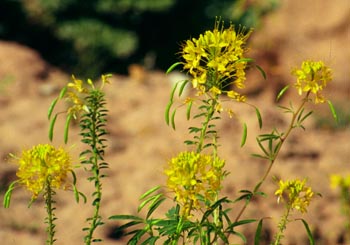Yellow Beeplant

Common Name(s):
Yellow Beeplant
Yellow Spiderflower
Scientific Name:
Cleome lutea Hook.
Scientific Name Synonyms:
None Known
Symbol:
CLLU2
Description:
Life Span: Annual
Origin: Native
Growth Characteristics: Yellow beeplant if often found growing from a few inches to five feet tall in very noticeable large colonies. It takes advantage of spring rains and starts to flower after a minimal growth. If spring and summer moisture continues, the plants will grow taller and continue to flower.
Flowers: Beeplants characteristically have 4 attractive petals that are crowded into rounded or rather elongate spikes, and stamens (pollen-bearing organs) that are longer than the flowers, giving the spikes a fuzzy appearance. Yellow beeplant flowers are yellow and are borne on a short stalk.
Fruits/Seeds: The seed capsule of beeplant is 3/8 to 1 ½ inches long. It hangs downward on long stalks. The capsule contains rough rounded seeds, which emerge after the pod dries out and splits longitudinally.
Leaves: Leaves of Yellow beeplant are on the lower half of the plant. They have 3-7 elliptical or lance-shaped leaflets that are from 3/8 to 2 inches long. The leaflets arise from a common point like fingers from a palm (palmate). Tiny, singular upper leaves occur on the flowering stems between individual flowers.
Stems: Yellow beeplant has stout stems.
Ecological Adaptions:
Yellow beeplant is often found in semi-desert, foothills, and montane zones, from 2700 – 7200 feet in elevation.
Soils: Often found on sandy soil. The plant prefers light (sandy) and medium (loamy) soils and requires well-drained soil. The plant can survive in a range of soil pH levels.
Associated Species: Sagebrush, quaking aspen, gambel oak.
Uses and Management:
Native Americans of the Southwest boiled the flowers or leaves to make a blackish pigment for painting pottery. The leaves, a good source of calcium and vitamin A, were eaten either raw or cooked. Ute Mountain Utes, in the Four Corners Region, ate the seeds of this plant as well. Beeplant seeds are commonly found in prehistoric archeological digs in the Southwest. A poultice made from the leaves was used by the Kayenta Navajo, in northern Arizona, to treat ant bites.

